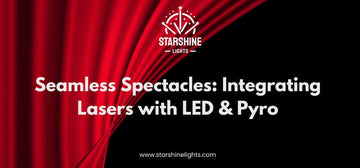Integration with Other Stage Effects: Crafting Seamless Multimedia Experiences
Modern live events demand more than standalone lighting; they require cohesive visual storytelling that blends multiple technologies. Integrating stage laser lights with LED screens, pyrotechnics, moving heads, and atmospheric effects creates dynamic, immersive environments that captivate audiences. This guide offers strategies for production managers, integrators, and event crews to synchronize lasers with other stage elements, ensuring flawless shows from start to finish.

1. Synchronizing Lasers with LED Screens
Why Combine?
LED screens deliver high-resolution imagery and video content, while lasers provide sharp beams and volumetric effects. Together, they offer depth and contrast that neither can achieve alone.
Best Practices:
Content Mapping: Design video content with “safe zones” where laser beams will intersect. Use software like Resolume or MadMapper to layer laser patterns over LED visuals.
Color Harmony: Match laser hues to dominant on-screen colors. For instance, pair your LED backdrop with the vibrant RGB output of the J1 RGB Laser Lights for perfect color matching.
Timing & Cues: Use a central control system (e.g., DMX or Art-Net) to trigger both video and laser cues simultaneously, avoiding visual lag.

2. Enhancing Pyrotechnics with Laser Accents
Why Combine?
Pyrotechnics provide explosive moments of fire and sparks, while lasers offer precise, controlled light. Lasers can trace the path of pyrotechnic bursts, drawing attention to key moments.
Best Practices:
Safety Coordination: Establish clear separation zones. Coordinate with pyrotechnics teams to ensure lasers do not interfere with flame trajectories or heat sensors.
Pre-Show Testing: Conduct dry runs without pyrotechnics, mapping laser beams around flame fixtures. Adjust beam angles to avoid unintended reflections.
Dynamic Pairing: Program lasers to pulse just before a fire effect, building anticipation. After the burst, use sweeping laser sweeps—such as those from the J5 Bluetooth Laser Light—to guide the audience’s gaze.
3. Blending Moving Heads and Lasers
Why Combine?
Moving head fixtures provide broad washes, gobos, and color mixing, while lasers cut precise lines and shapes. Their union allows for layered lighting designs with both volume and texture.
Best Practices:
Layered Angles: Position moving heads at mid-stage height, casting broad washes. Place lasers from higher trusses to project sharp beams above the wash layer, creating a multi-tiered effect.
Gobo & Laser Synchrony: Match moving head gobo patterns to laser animations. For example, a circular gobo wash can complement rotating laser rings.
Control Integration: Use a unified console to control both moving heads and programmable laser lights, ensuring smooth transitions and synchronized movements. For party environments, the versatile C2 Party Laser Lights offer both laser beams and built-in moving effects.
4. Incorporating Atmospheric Effects
Why Combine?
Atmospheric effects like haze, fog, and low-lying mist reveal laser beams and enhance volumetric visuals, making light paths visible to the audience.
Best Practices:
Consistent Output: Use a steady haze machine rather than intermittent fog bursts. This maintains a uniform beam reveal throughout the performance.
Layered Density: Adjust haze density based on laser intensity—higher-power lasers require less haze to remain visible.
Safety Considerations: Ensure proper ventilation and monitor haze levels to avoid obscuring LED screens or pyrotechnic sensors. Enhance star-like effects with a Starry Sky Light to scatter ambient points of light.

5. Designing for Outdoor Laser Light Projectors
Why Combine?
Outdoor venues pose unique challenges—ambient light, long throw distances, and weather. Integrating lasers with large-scale video projections, architectural lighting, and landscape fixtures creates impactful outdoor spectacles.
Best Practices:
High-Power Units: Choose outdoor laser light projectors with sufficient lumen output to overcome ambient conditions.
Architectural Mapping: Pair lasers with facade projections to highlight building features. Use mapping software to align laser outlines with architectural contours.
Weatherproofing: Ensure all fixtures, including party laser lights and laser lights outdoor, are rated for outdoor use and protected against moisture and dust.
6. Case Study: DJ Laser Lights and Disco Laser Lights Fusion
Scenario: A nightclub set combines dj laser lights, disco lasers, and LED dance floors.
Implementation:
Program disco laser lights to respond to BPM data, creating rhythmic pulses.
Sync LED floor tiles with laser patterns for a unified dance floor effect.
Use laser show lights above the DJ booth to frame the performer, drawing audience focus.

Integrating stage lasers with LED screens, pyrotechnics, moving heads, and atmospheric effects elevates event production from standard to spectacular. By following these strategies—synchronizing cues, ensuring safety, and leveraging unified control systems—production managers and integrators can deliver seamless multimedia stage designs that leave lasting impressions. Embrace the power of integrated stage effects and transform your next live event into an unforgettable visual journey.



























